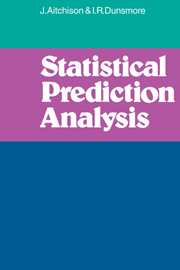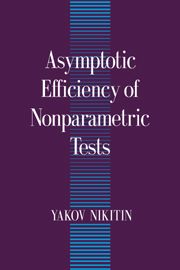Refine search
Actions for selected content:
2348 results in Statistical theory and methods
Preface
-
- Book:
- Algebraic and Geometric Methods in Statistics
- Published online:
- 27 May 2010
- Print publication:
- 22 October 2009, pp xiii-xv
-
- Chapter
- Export citation
2 - Maximum likelihood estimation in latent class models for contingency table data
- from Part I - Contingency tables
-
-
- Book:
- Algebraic and Geometric Methods in Statistics
- Published online:
- 27 May 2010
- Print publication:
- 22 October 2009, pp 27-62
-
- Chapter
- Export citation
9 - Generalised design: interpolation and statistical modelling over varieties
- from Part II - Designed experiments
-
-
- Book:
- Algebraic and Geometric Methods in Statistics
- Published online:
- 27 May 2010
- Print publication:
- 22 October 2009, pp 159-174
-
- Chapter
- Export citation
26 - Geometry of extended exponential models
- from Part V - On-line supplements
-
-
- Book:
- Algebraic and Geometric Methods in Statistics
- Published online:
- 27 May 2010
- Print publication:
- 22 October 2009, pp 427-430
-
- Chapter
- Export citation
17 - Axiomatic geometries for text documents
- from Part III - Information geometry
-
-
- Book:
- Algebraic and Geometric Methods in Statistics
- Published online:
- 27 May 2010
- Print publication:
- 22 October 2009, pp 277-290
-
- Chapter
- Export citation
25 - Replicated measurements and algebraic statistics
- from Part V - On-line supplements
-
-
- Book:
- Algebraic and Geometric Methods in Statistics
- Published online:
- 27 May 2010
- Print publication:
- 22 October 2009, pp 424-426
-
- Chapter
- Export citation
18 - Exponential manifold by reproducing kernel Hilbert spaces
- from Part III - Information geometry
-
-
- Book:
- Algebraic and Geometric Methods in Statistics
- Published online:
- 27 May 2010
- Print publication:
- 22 October 2009, pp 291-306
-
- Chapter
- Export citation
Contents
-
- Book:
- Algebraic and Geometric Methods in Statistics
- Published online:
- 27 May 2010
- Print publication:
- 22 October 2009, pp vii-viii
-
- Chapter
- Export citation
List of contributors
-
- Book:
- Algebraic and Geometric Methods in Statistics
- Published online:
- 27 May 2010
- Print publication:
- 22 October 2009, pp ix-xii
-
- Chapter
- Export citation
20 - Quantum statistics and measures of quantum information
- from Part III - Information geometry
-
-
- Book:
- Algebraic and Geometric Methods in Statistics
- Published online:
- 27 May 2010
- Print publication:
- 22 October 2009, pp 327-338
-
- Chapter
- Export citation
7 - The algebraic complexity of maximum likelihood estimation for bivariate missing data
- from Part I - Contingency tables
-
-
- Book:
- Algebraic and Geometric Methods in Statistics
- Published online:
- 27 May 2010
- Print publication:
- 22 October 2009, pp 123-134
-
- Chapter
- Export citation
22 - Maximum likelihood estimation in latent class models for contingency table data
- from Part V - On-line supplements
-
-
- Book:
- Algebraic and Geometric Methods in Statistics
- Published online:
- 27 May 2010
- Print publication:
- 22 October 2009, pp 373-394
-
- Chapter
- Export citation
Part IV - Information geometry and algebraic statistics
-
- Book:
- Algebraic and Geometric Methods in Statistics
- Published online:
- 27 May 2010
- Print publication:
- 22 October 2009, pp 339-340
-
- Chapter
- Export citation
8 - The generalised shuttle algorithm
- from Part I - Contingency tables
-
-
- Book:
- Algebraic and Geometric Methods in Statistics
- Published online:
- 27 May 2010
- Print publication:
- 22 October 2009, pp 135-156
-
- Chapter
- Export citation

Statistical Prediction Analysis
-
- Published online:
- 12 October 2009
- Print publication:
- 18 September 1975

Asymptotic Efficiency of Nonparametric Tests
-
- Published online:
- 18 September 2009
- Print publication:
- 30 June 1995
Epilogue - The Art and Science of Cause and Effect
-
- Book:
- Causality
- Published online:
- 05 March 2013
- Print publication:
- 14 September 2009, pp 401-428
-
- Chapter
- Export citation
9 - Probability of Causation: Interpretation and Identification
-
- Book:
- Causality
- Published online:
- 05 March 2013
- Print publication:
- 14 September 2009, pp 283-308
-
- Chapter
- Export citation
Contents
-
- Book:
- Causality
- Published online:
- 05 March 2013
- Print publication:
- 14 September 2009, pp vii-xiv
-
- Chapter
- Export citation
11 - Reflections, Elaborations, and Discussions with Readers
-
- Book:
- Causality
- Published online:
- 05 March 2013
- Print publication:
- 14 September 2009, pp 331-400
-
- Chapter
- Export citation
